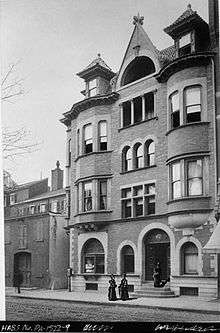Minerva Parker Nichols
.jpg)
Minerva Parker Nichols (1860–1949) was an architect from the United States.
Biography
After studying at the Philadelphia Normal Art School, Nichols joined the architectural firm of Frederick G. Thorn in Philadelphia. She took control of the firm after Thorn's death in 1888 and held the position for seven years. In 1896, she and her husband left the Philadelphia area and she began a private practice mostly for friends and relatives.[1]
Nichols was the second (after Louise Blanchard Bethune) American female architect who established a very successful, although brief, business and recognition, and the first one who did so without partnership or assistance of a man.[2][3][4] Nichols died in 1949 when she fell to her death while inspecting the roof of her daughter's house which she designed.[5]
Notable buildings

- New Century Club (Philadelphia)
- New Century Club (Wilmington, Delaware)
- Buckingham Browne & Nichols school, Cambridge, Massachusetts (1894)[3]
References
- ↑ Zaitzevsky, Cynthia. Long Island Landscapes and the Women who Designed Them. New York: W. W. Norton and Co., 2009: 257. ISBN 978-0-393-73124-8
- ↑ Margaret Lester, Specialization and Significance: An Assessment of the Career and Works of Minerva Parker Nichols
- 1 2 editor, Edward T. James, editor ; Janet Wilson James, associate editor ; Paul S. Boyer, assistant (1974). Notable American Women, 1607–1950: A Biographical Dictionary (3. print. ed.). Cambridge, Mass.: Belknap Press of Harvard University Press. p. 630. ISBN 0-674-62734-2.
- ↑ Prather-Moses, Alice Irma (1981). "Nichols, Minerva Parker". The International Dictionary of Women Workers in the Decorative Arts. The Scarecrow Press. p. 122. ISBN 0-8108-1450-1.
- ↑ "A Designing Woman Far Ahead Of Her Time". philly-archives. Retrieved 2015-10-15.
External links
| Wikimedia Commons has media related to Minerva Parker Nichols. |
- "Minerva Parker Nichols: A First American Woman Architect, 1860-1943"
- Minerva Parker Nichols at Philadelphia Architects and Buildings
- Preserving Minerva, website by architectural historian Molly Lester